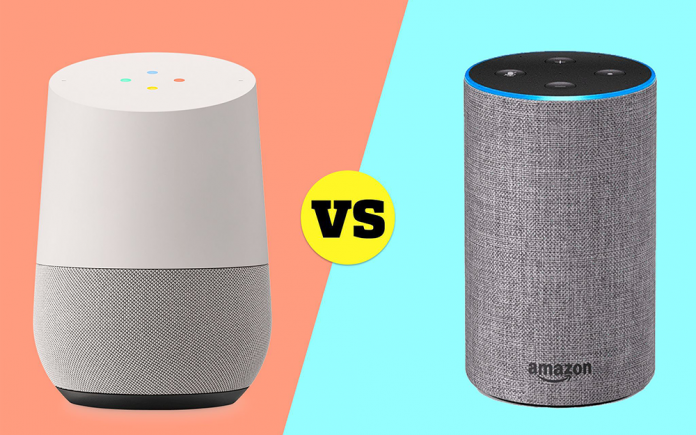
The differences, and what’s the right choice for you?
By Dennis Shelly
The Google Nest (previously known as Google Home) and Amazon Echo are not just speakers, they are complete ecosystems. While their physical hardware has rarely been upgraded, the services that enable them—Alexa and Google Assistant—are constantly changing. A smart speaker is typically a point of entry into a voice assistant ecosystem. When you choose between Google Echo or Amazon Nest, you’re picking a side: whether to voice-enable your home with Alexa or Google Assistant as each platform has its strengths. They both come in several form factors, work well as virtual assistants, let you manage a range of smart home devices, and compete with a variety of additional features and functionalities.
Although both devices would provide an excellent smart home experience, the following comparisons may assist you in deciding which is the best option for you.
Google Home vs. Amazon Alexa
Google Home is a smart home hub from Google that works with other Google products such as Chromecast, Nest Thermostats, and Nest Cams. This hub can carry on contextual discussions and respond to various instructions in a seamless manner.
Alexa is an Amazon platform that is built into the Amazon Echo hub. Alexa is a virtual assistant that can learn new instructions and is updated on a regular basis to become more “human-like.” Alexa works best in a house with an Amazon Fire Stick, Ring Cams and Doorbells, or perhaps an ecobee smart thermostat.
Features and Specifications
Both come with a variety of features that enable you to operate your smart home as well as listen to your favorite music. Both devices allow you to use voice commands to adjust the temperature, switch on lights, lock a door, and more. Best of all, they’re both compatible with some of today’s most popular gadgets, such as Nest thermostats and Philips Hue lighting. If you’re looking for audio, both devices are speakers that can play music, podcasts, audiobooks, and any other audio you can think of. However, because neither has a screen, don’t expect them to operate with video. Instead, you’ll need to consider a smart display.
Design
When you first open Google Home, the first thing you’ll notice is its unique look. The device features a gray fabric on the bottom and a white area on the top. That white section has a slanted top with LED lights that indicate if the gadget is on, listening to what you say, and so on. It’s small attractive. The Amazon Echo 3, like its predecessors, takes a somewhat different approach. The fabric exterior gives it more softened edges and a more welcoming appearance. It has a cylindrical form and is available in a range of colors, including charcoal, gray, sandstone, and others. Physical controls for turning the microphone on and off, as well as indicator lights around the top ring that let you know the device is listening, are located at the top. Whereas Google Home appears like a tech device no matter where you set it, Amazon’s Echo is a better match for any environment due to its different materials and styles.
Sound and Music: Quality vs. Volume
In terms of sound quality, Google’s flagship Home and Amazon’s flagship Echo are basically on par with middle-of-the-road Bluetooth speakers, or about what you’d expect from a great built-in television speaker. The Google Home has a better, more realistic sound than the Echo, but the Echo with Alexa can be turned up louder. Sound quality is more complicated than that, with the Home Max having stronger bass response and less vibration than the Echo Studio, and the Echo Dot sounding somewhat better than the Google Home Mini. It’s a draw when it comes to interoperability with internet streaming services. Except for their own services, both ecosystems provide broad interoperability. In terms of wired connectivity, Alexa devices win hands down, with 3.5mm connectors on every device in the series. If you prefer wireless connections, this isn’t a major concern, but it’s something the Google Home devices lack.
Voice Controls and Skills
With natural-sounding voices and good speech recognition, both Google Home and Amazon Alexa perform well as virtual assistants. One major difference is that Google Home devices only respond to two wake phrases, “Okay, Google” and “Hey, Google.” When you say Alexa, Echo, Amazon, or computer, an Echo device will wake up. Both aren’t perfect; custom wake words would be nice, but Alexa is the more versatile option. Google Home takes the lead in terms of voice options. Alexa has a single voice that sounds nice, but Google Home has a number of other voices to choose from if you want to change things up. Although both systems have excellent speech recognition, the Google Assistant-powered Home is better at answering general knowledge questions and interpreting web-based queries. If you don’t use specific wording, Alexa gets stuck, and it depends on Wikipedia a lot more than Home does. Some queries need the inclusion of a skill since Alexa cannot answer them on her own.
Third-Party Support
Amazon’s Alexa used to be the obvious winner when it came to third-party device and service compatibility, but Google is catching up. Amazon Alexa already supports over 100,000 “skills,” including ordering pizza, listening to music, and managing smart home devices. In any case, Amazon’s Alexa still rules supreme when it comes to controlling third-party devices and services through a smart home device. Although Google Home doesn’t have the same amount of third-party compatibility as Alexa, for the great majority of consumers, it will suffice.
Availability and Pricing
Both Google Home and Amazon Echo are now available at low costs. Even better, you can find them almost anywhere, including Amazon, Best Buy, Target, Walmart, and other retailers.
The Echo from Amazon costs $39.99.
Google Home normally costs $129, is now available for $99.
Smart Home Integration and Connectivity
Both Google Home and Amazon’s Alexa devices work well as the backbone of a smart home. Alexa can connect to more devices without a lot of fiddling around, but the difference isn’t significant. Before buying a number of Google Home and Home Mini devices, make sure your existing smart home gadgets are compatible with Google Home. Home can do pretty much everything Alexa can do in terms of managing lights, thermostats, garage doors, and other smart home hardware. There are a few significant differences, such as the fact that Google Home works with Chromecast out of the box, whereas Fire TV is designed to connect with Alexa, so keep that in mind if you’ve invested in either Google or Amazon’s television streaming hardware. There are also some differences in how the Home and Alexa devices handle speech and, in the case of the Echo Show, video calling. Voice over IP (VoIP) allows Google Home devices to make phone calls, so you may use your internet connection to contact a smartphone or landline with your Google Home.
Both are excellent products, and the decision will largely come down to your preferences. Google Home is easier to talk to and is a little wiser straight out of the box. It’s the best option if you’re primarily seeking for a personal assistant. It’s also great for anyone with a Chromecast or Cast-enabled speakers thanks to Google’s Cast integration. In terms of smart home support (barring the odd device), app control, and routines, it now matches Amazon. Echo, on the other hand, offers a wider range of speakers, including the fancy screen-enabled Echo Show. While Alexa is a bit more difficult to interact with, the Echo’s vast skill set means it can accomplish significantly more than Google Home. Smart home control is still great, but Amazon no longer has the edge, and Google now equals Amazon feature for feature. If you want a system with more expandable skills and a larger selection of devices, go with Amazon Echo; if you want a better personal assistant, go with Google Assistant.
Still not sure which smart home solution is right for you? Or perhaps have some additional questions? Our Eggsperts are standing by to help. Please contact us by visiting our website www.eggheadit.com by calling (760) 205-0105 or emailing us at tech@eggheadit.com with your questions or suggestions for our next article.
IT | Networks | Phones | Security | Automation










































